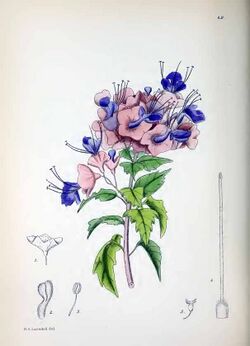Biology:Karomia speciosa
| Karomia speciosa | |
|---|---|

| |
| Karomia speciosa[1] | |
| Scientific classification | |
| Kingdom: | Plantae |
| Clade: | Tracheophytes |
| Clade: | Angiosperms |
| Clade: | Eudicots |
| Clade: | Asterids |
| Order: | Lamiales |
| Family: | Lamiaceae |
| Genus: | Karomia |
| Species: | K. speciosa
|
| Binomial name | |
| Karomia speciosa (Hutch. & Corbishley) R.Fern.
| |
| Synonyms[2] | |
| |
Karomia speciosa is an African deciduous large shrub or bushy tree up to 7 m, and relocated to the family Lamiaceae from Verbenaceae. It is one of 9 species in the genus Karomia, a genus containing species previously classified in Holmskioldia, and is closely related to Clerodendrum. The only remaining species in the genus is Holmskioldia sanguinea, occurring in the foothills of the Himalayas.[3]
Karomia speciosa is found in the northern parts of South Africa , Eswatini and north into tropical Africa and Madagascar , growing in bush or wooded areas on hot, dry, rocky slopes and riverine thickets. Producing showy, mauve and purple flowers in profusion, the species is either single- or multi-stemmed, with pale, smooth grayish-brown bark. The softly pubescent leaves have coarsely toothed margins, are dark green above and a paler green below. The papery calyx is dusty-pink or mauve in colour, while the bilabiate corolla is deep-blue or violet.[4]
Branchlets woody, terete, shortly and softly pubescent, marked with pale lenticels ; internodes about 2 cm. long. Leaves broadly ovate, triangular at the apex, broadly wedge-shaped at the base, 2-5-4 cm. long, 2-3 cm. broad, coarsely crenate, with few (about three) rounded teeth, very shortly setulose above, paler below and conspicuously glandular and shortly pubescent ; lateral nerves about three on each side of the midrib ; petiole 7 mm. long, densely pubescent. Flowers few, arranged in axillary cymes about 4 cm. long ; peduncles slender, softly pubescent; lower bracts more or less leafy, spathulate-obovate, up to 7 mm. long; pedicels up to 1.2 cm. long, with two small opposite linear bracteoles above the middle. Calyx pink-coloured, gradually enlarging, broadly top-shaped, glandular-pubescent outside; tube 1 cm. long, with broadly rounded lobes, the latter rigidly membranous in the fruiting stage and expanding to 25 cm. Corolla purple, 2-2.5 cm. long, glandular and softly pubescent outside; tube up to 1.5 cm. long. Stamens long exserted; filaments glabrous. Ovary hairy in the upper part ; style a little longer than the stamens, slender, glabrous. Fruit truncate, 4-horned, included by the accrescent calyx.—J. Hutchinson
References
- ↑ I. B. Pole Evans, Kathleen Annie Lansdell. 1922. "Flowering Plants of South Africa" vol.2 https://archive.org/stream/floweringplantso02pret#page/n3/mode/2up
- ↑ "Karomia speciosa (Hutch. & Corbishley) R.Fern.". World Checklist of Selected Plant Families (WCSP). Royal Botanic Gardens (Kew). http://www.theplantlist.org/tpl1.1/record/kew-105592.
- ↑ Unit, Morphometrics and Ident.. "eFloras Results For Holmskioldia speciosa". http://apps.kew.org/efloras/namedetail.do?flora=fz&taxon=11666&nameid=29852.
- ↑ "Karomia speciosa | PlantZAfrica.com". http://www.plantzafrica.com/plantklm/karomiaspeciosa.htm.
External links
Wikidata ☰ Q15336083 entry
 |

